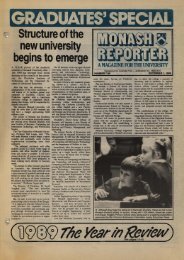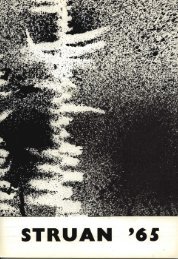MONASH UNIVI:::RSlTY (jAZLTTEof the faculty of Law, told of Professor Derham's greatcontribution to the <strong>Monash</strong> law school and to universityteaching of law in Australia generally.He spoke of the changes which had taken place inAustralian law schools since the end of the secondworld war, the most conspicuous of which had been theincrease in the numbers of full-time students of law, thelarge and still growing faculties of full-time teachers, andthe differences in the organization of degree courses, inthe curriculum and in the modes of teaching law.He described the lively concern that Professor Derhamhas shown for the development of university lawteaching, for the relations between university studies inlaw and the demands and standards of the legal profession,for the relation between the study of law andthat of other disciplines and for the development of lawas part of a liberal <strong>edu</strong>cation for those interested in manand his social relations and behaviour.Professor Derham had encouraged his colleagues toconsider and reconsider their approaches to the teachingof law and to the stereotyped practices of another time.He also encouraged them to pursue their own researchand to maintain strong links with law schools throughoutAustralia and in England and the United States.Despite the heavy responsibilities of his teaching andhis office as dean, he undertook many important tasks inthe community. He was a part-time Commissioner ofthe Australian Universities Commission; a member ofthe Commonwealth Committee on the Future of TertiaryEducation in Australia; a member of the Chief Justice'sReform Committee; a member of the Victorian Councilof Legal Education; and a member of the Legal EducationCommittee of the Council of Legal Education,responsible for the courses for articled clerks given atthe Royal Melbourne Institute of Technology.Continuing his address, Professor Waller said:"David Derham was appointed as the first dean ofLaw on 13 October 1963. It was an appointment whichwas generally acclaimed bec<strong>au</strong>se of his reputation as alegal scholar, as a law teacher and as a scholar andteacher deeply concerned in the development of lawteaching was already established. He accepted theresponsibility of instituting teaching in law as quickly aspossible, and the first classes were held in March 1964.He early expressed the view that law students at <strong>Monash</strong><strong>University</strong> must be given the opportunity, and be plac<strong>edu</strong>nder the obligation, to pursue studies in disciplines outsidethe law. He did not want law students to bewithout history or literature, philosophy or economics,to be, in Scott's phrase, 'mechanics, or mere workingmasons'. In possession of some knowledge of thesedisciplines, they might venture to call themselves architects.Accordingly, he formulated plans which providedfor a first degree in law - Bachelor of Jurisprudencewith its basic core or legal subjects together with studiesin the humanities, economics 0'- the natural sciences.This was to be followed by further study for theBachelor of Laws, requiring the mastery of a widerrange of legal subjects and serving as a qualification forprofessional practice. His plan was accepted by the<strong>University</strong> and then brought to life under his carefuland imaginative direction".In responding to Professor Waller's citation, ProfessorDerham said:"I want to thank this great <strong>University</strong> for the honourit has done me today - I could, I think, say - 'for thehonours it has heaped upon me today'. I am a littleembarrassed to be addressing you here on this occasionbec<strong>au</strong>se I know that these honours are more than Ideserve. But if I were to demonstrate that, I would becriticizing the judgement of men I respect and admireand of a <strong>University</strong> for which I have the highest regardand admiration."Perhaps I should say little more on that matter thanthank you - and I do say thank you most sincerely.'This day and this ceremony mark the firm establishmentof something which I believe to be of very greatimportance indeed. When a great law school is seenfor the first time to be firmly established, as this lawschool now is, only the beginning of a great achievementhas been completed. The full recognition of the natureof the achievement will not come until long afterwardswhen the next generation sees what the men and womenwho pass through the school have done for the nationand for the world. But the successful establishment ofthe school in the beginning is itself an achievement, andI see my place in today's ceremonies really as a symbolof that achievement and not more."For these things are not done by one man, nor bytwo or three men. They are brought about bymany men contributing their talents, their work and theirenthusiasms to the attainment of a common objective.There are now too many whose diligence and devotionhave brought this law school to its present place for allof them to be named and thanked on an occasion suchas this. It should be remembered, however, that it is notonly the small group of lawyers who, with quakingfaith. took responsibility for the original venture, noronly the fifty or so imaginative lawyers who have beenconcerned with nurturing the school since those earlydays; it is not only those who made the present achievementspossible. It is also the leaders of the otherfaculties in this <strong>University</strong> and the senior members ofthe <strong>University</strong>'S administrative staff who made successcertain. for without the co-operative and imaginativework of all of them success in the time given would havebeen impossible."It is a remarkable thing that a <strong>University</strong> presidedover by an engineer Chancellor, and an engineer ViceChancellor, neither of whom, I suspect, has any specialreason to love the law, should have established this lawschool with its special characteristics in a mere fourand a half years. I do not believe that there is anotheruniversity in the United Kingdom or in Australasia, perhapsnot in the common law world, which could havedone so well in so short a time. But when law teachingbegan here a mere three years after the first studentswere enrolled to read in other faculties, <strong>Monash</strong> wasalready accustomed to doing things quickly, and withenthusiasm".Professor Derham went on to consider the fundamentalplace of law and of legal systems in all humancommunities. Then, turning to the fashioning of the lawcourses at <strong>Monash</strong>, he said:"A learned and perceptive critic once said of thegreatest of our common lawyers, Sir Owen Dixon, thatthroughout his judicial career he struggled with adilemma produced by his belief in the need to maintainthe <strong>au</strong>thority of the law, on the one hand, and by hisdesire to eradicate error, on the other.26
"1 do not believe that is a true dilemma. What maybe true is that to resolve the apparent dilemma is thelawyers' primary task; and that the secret of success is tobe found in the dimension of time. It is certain thatsuccess is not possible without looking outside the limitsof the formal rules of law to the interaction betweenlaw and life."There were other reasons, it is true, but those werethe fundamental reasons why, at <strong>Monash</strong>, a new kindof law course was devised for this <strong>University</strong>'s lav..·degrees.'The course for the first degree was designed to providea basic university <strong>edu</strong>cation with almost equalrequired reading in non-legal subjects as in the law; andonly the second concentrated upon legal subjects withthe practice of law in view. That plan made a fiveinsteadof a four-year course essential. But that was asmall price to pay if the foundations were laid to buildfor a greater capacity to resolve the apparent dilemma Idescribed earlier."One result of the establishment of those two degreesis that the <strong>Monash</strong> LL.B. degree as such is a mark ofa more balanced and complete university attainmentthan any LLB. degree 1 know in the United Kingdom orAustralasia. In many universities of those regions therequirements of the <strong>Monash</strong> LL.B. degree would justifythe conferring of the degree of Master of Laws."With the staff of this school and the physical advantagesof this building also in mind, [ have no hesitationin assuring the graduates of this school that the standardsthey satisfy here are as high as any in the common lawworld. They can be proud to be graduates of <strong>Monash</strong><strong>University</strong> as I am proud to become an honorary graduateof <strong>Monash</strong> today."I am greatly honoured today to be asked to open thisbuilding and with much pleasure I do now declare thislaw school building open".Professor D. P. Derham receives his honorary degreefrom the Chancellor (ll·ft). Seated, Professor P. L.Waller, acting dean of the faculty of LawLEARNING EXPERIMENTSWITH FISHBy R. F. Mark, Senior Lecturer,Department of PhysiologyDuring the last thirty years we have lived through agolden age in the experimental investigation of thebrain. More than anything else, the advance has comethrough the ability to record in isolation the electricalactivity of single cells amongst the millions that makelip each brain. Properly done, this allows the piecingtogether of a mosaic of response patterns of individualneurones and gives a degree of understanding of themechanism of the brain that was not possible before.The same techniques, pushing modern electronicmethods to the very limits of resolution, have beenapplied to the biophysical mechanisms of the individualnerve cell, and now there seems no reason why thedescription of nerve cell signalling should not soonreach the level of single molecules and be described inthe same terms as the chemical basis of life itself.Yet the two aspects of brain function that have thegreatest medical and scientific interest have been almostuntouched by this advance. These are firstly the understandingof the detailed growth and development of thebrain, with all the implications for knowledge of normaland abnormal mental development, and secondly themechanism of the long-term changes in the brain thatmust underlie processes of perception and memory.The problems are so difficult that only as a result ofrecent knowledge has it been possible to put them inscientific terms in which they can be analysed bysimple experiments. Even so the complexity of thehuman or mammalian brain makes the going very difficult.As so of len in science one looks for a model,retaining the properties of interest but leaving out thatwhich is confusing and probably irrelevant. It becomesof very great importance then to know whether loweranimals and simpler forms of life see and feel andremember as we do. The more primitive the animal thesimpler the brain and the easier in theory is the analysisof its physical mechanism. For this reason, in thePhysiology department of the medical school, the visualand learning abilities of fishes are being studied in detailand the contribution of various parts of the brain tothese abilities is being examined.WAYS OF TEACHING FISHThere is a long history of experiments on trammgfishes to respond to various visual stimuli and it provesquite easy to teach even the common goldfish to recognizelights, colours and sounds or more complicatedpatterns such as printed letters of the alphabet. The artof doing so is to make it possible for the fish to revealhis choice by some clear change in behaviour. Thereare numerous methods. The illustrations show someways, all of which are in use in our laboratory, in whichthis can be done. Fig. I is a diagram of an arrangementthat can teach a fish to respond to a sudden increase inlight level by leaving the lighted area and swimming toa darkened part of the tank.! A hurdle going almost tothe surface of the water divides a tank into two iden1 Steiner, J. and Mark, R. F.-Are memories stored inthe fish tectum? Aust. J. Exp. Bioi. Med., 1968,(in press).27
















